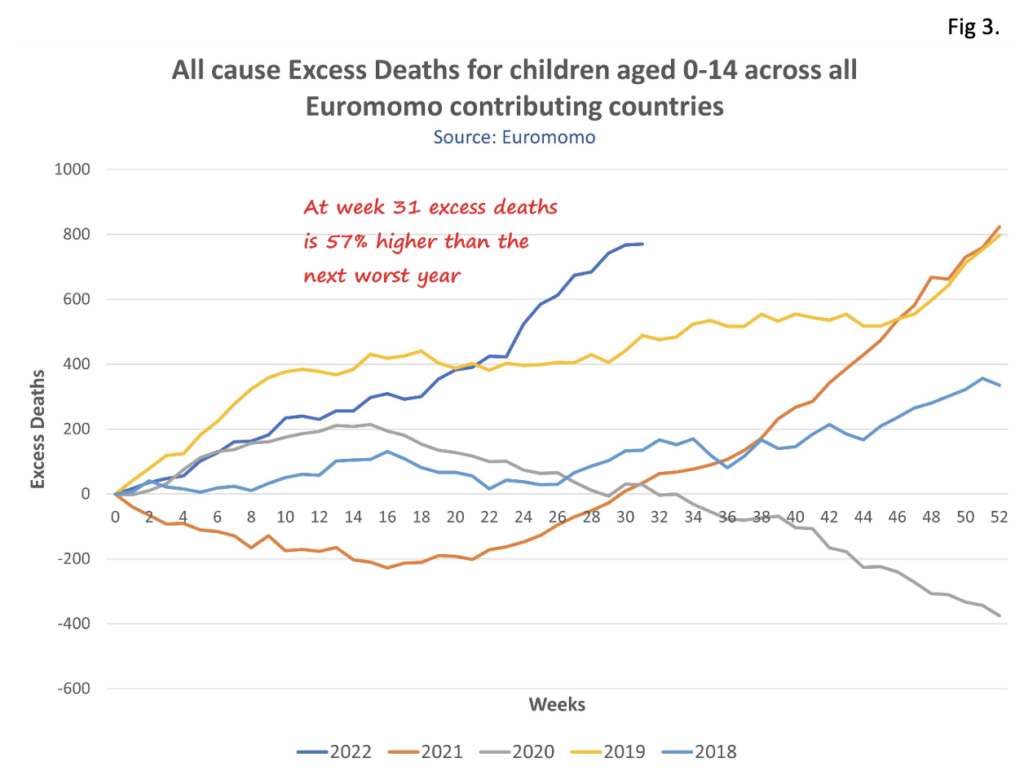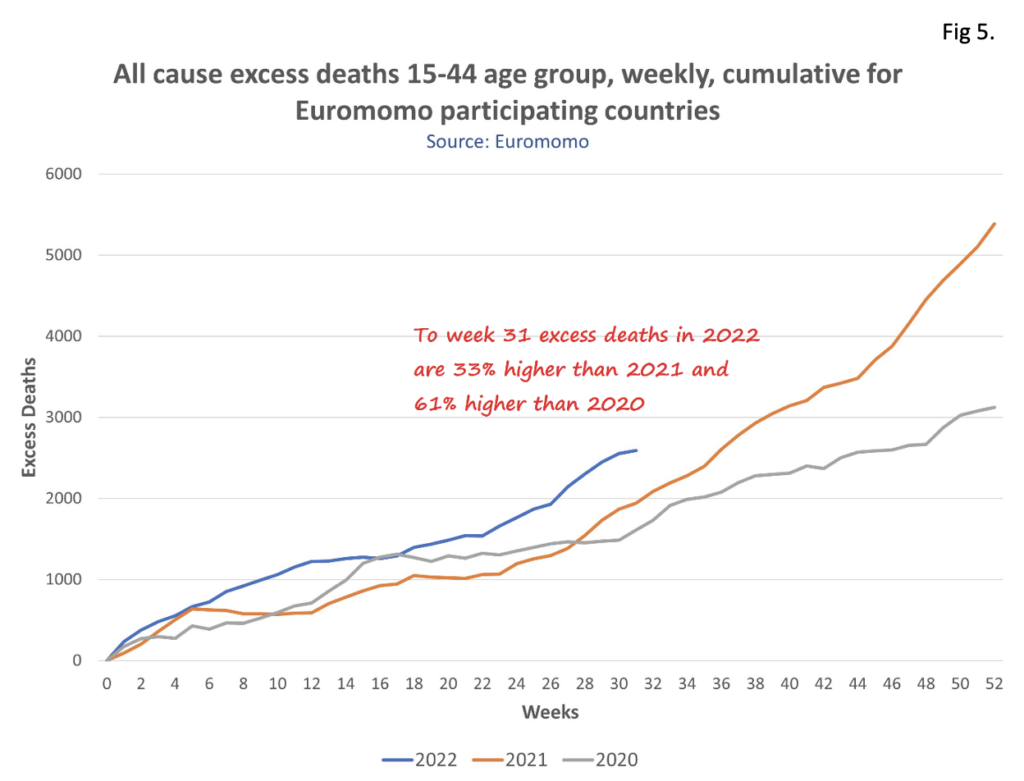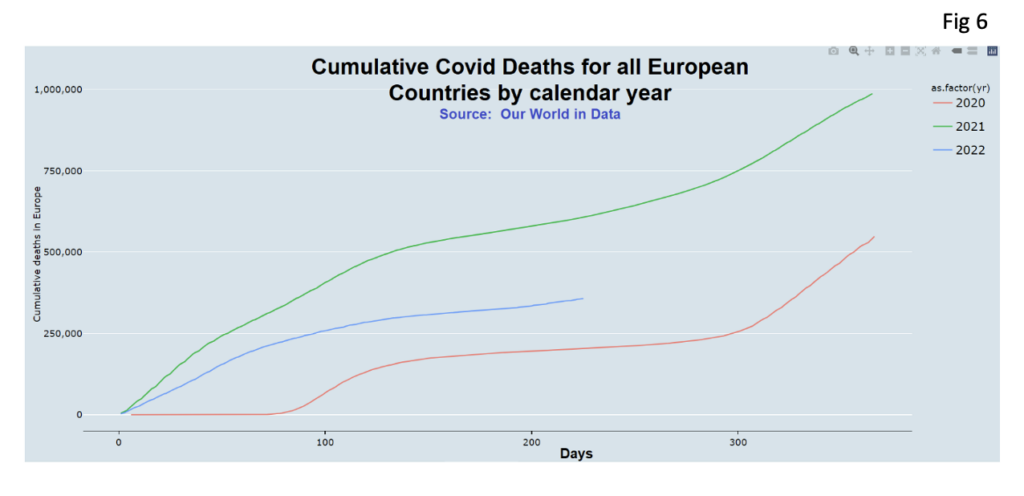Euromomo tells us that by week 31 of 2022 there have been 3,360 excess all-cause deaths of people under 45 across the Euromomo contributing countries. This compares with 1,640 excess all-cause deaths by week 31 in 2020 in the under-45s, an increase of 105%. All-cause, of course, includes Covid deaths.
On first reading that headline you might think, OMG, quick bring back masks, impose social distancing, close the schools! But this has got virtually nothing to do with Covid which represents a very low percentage of deaths in the under-45s.
If I really wanted to spread fear and alarm, I’d concentrate on the year-to-date excess death figures for children aged 0-14, up an incredible 2,555% in 2022 on the 2020 figure! In 2020 by week 31 across all Euromomo participating countries there had been 29 excess deaths in this age group. Incredible! 29 excess deaths across virtually the whole of Europe while a once in a century pandemic was ravaging the land? This year, by contrast, by week 31 we’ve had 770 excess deaths among 0-14 year-olds. How’s that for a headline: “Child excess deaths up by over 2,500%.” But of course, it’s virtually meaningless. The Euromomo countries (see Fig 1) cover most of the big European countries, so 29 deaths or even 770 deaths across all those millions is still barely a ripple – unless it’s your child, of course.

Let me be clear. I’m not saying that parents of children should be worried, the point is they shouldn’t be worried now in 2022 and they shouldn’t have been worried back in 2020 or 2021. Right through the pandemic fiasco children have not been at any more risk than they’ve been in any other year. It’s the old story of absolute and relative risk. Buy a Euro lottery ticket to win £100 million and you’ve got as close to a zero chance of winning as makes no difference; buy two lottery tickets and you’ve just mathematically doubled your chance of winning. But, let me break it to you, you still won’t pocket the £millions.
The Euromomo charts compare deaths to a ‘baseline’. The baseline is the expected level of deaths. Euromomo then calculates the extent to which the actual has moved away from the expected.
Having given you the trigger warning, Fig 2 shows the Euromomo data for 0-14 year-olds for just 2020 and 2022 in comparison to the ‘baseline’ of expected deaths. To be clear, this data is for all contributing Euromomo countries which include the U.K.

Across a big chunk of Europe in 2020 kids had never been safer. During 2020 almost 400 fewer under 15 year-olds died than normally do. And that lump at the beginning of 2020 wasn’t Covid causing deaths. There have been hardly any deaths of children from Covid. Indeed, prior to week 10 of 2020 there were hardly any deaths of anyone from Covid. In fact, the remarkable thing about child deaths in 2020 was that they were the lowest of any of recent years. But look at 2022 in comparison to recent years. Deaths of under 15 year-olds is at a five-year high. Figure 3, below, is the same chart but with 2021, 2019 and 2018 added just to add context.

2022 is on target to be by far the worst year since 2018, currently 57% higher than the next worse year of 2019. In 2022 we’ve already seen almost as many excess deaths as in the full 12 months of the next two worst years, 2019 and 2021. But none of this has got anything to do with Covid, unless you include shutting our kids inside which had the result that fewer died in road accidents, drownings and other accidents. They’re high but I don’t think the numbers are a cause for panic. Rather, it’s a cause for concern. No one appears to know the reason for this, but I’d have thought it was something worth looking into. I don’t know that anyone is.
Again, let’s add a bit of context. On the July 23rd the WHO announced that Monkeypox is a Public Health Emergency of International Concern. There had, reportedly, been five deaths up to this point, none outside Africa where, in certain parts, monkeypox is endemic. What’s more, it’s not as if avoiding Monkeypox is a complex problem to solve. Virtually all the victims are men who have sex with multiple other men; don’t do that and there’s a strong chance you won’t get Monkeypox. There you go, a simple to explain, cheap to execute solution, job done. Now getting back to why we’ve got such relatively high excess deaths among the under-15s – that’s a thornier issue. If the WHO thinks it’s worthwhile declaring a public health emergency of international concern after five Monkeypox deaths, shouldn’t 770 excess deaths of children also be flagged as a public health emergency?
But it doesn’t stop there.
Across the contributing Euromomo countries, all-cause, all-age excess mortality is virtually the same at this stage of the year for 2020, 2021 and 2022. Intuitively, that seems strange. 020 was the year of a once-in-a-century pandemic hitting a naïve population. Since then, we’ve vaccinated getting on for 90% of the population multiple times. Evolution has been kind to us and the original Wuhan strain is now the relative pussycat that is Omicron. We’ve got masses of natural immunity – is that a thing anymore? I forget. Anyway, we should be in a vastly better place than in 2020, and yet we’re not.
Let’s return to the Euromomo data. In 2020 as at August 11th there were 214,115 all-age excess deaths. To August 11th 2021, there were 194,280, a 9% reduction on 2020. Yet in 2022 by August 11th it had reached 205,249, an increase of 6% on 2021, almost on a par with 2020.

That’s all-cause excess mortality for all age groups, virtually the same in 2020, 2021 and 2022 in comparison to the baseline. What happens if we again look at the younger age groups?
If we look at excess deaths of people aged between 15 and 44 (see Fig 5), we see that excess all-cause mortality is 61% higher in 2022 than in 2020.

So what’s going on? The USA, Europe, the U.K. and Australia all operate systems to collect reports of adverse events linked to vaccine shots:

Associate Professor Christopher Neil MBBS, FRACP, PhD, the Incoming President of the Australian Medical Professionals Society, has written an open letter about this, citing the rule-of-thumb yardstick that these early warning system only catch about 10% of all adverse events. Still, the results as they stand – 3,270,859 adverse events and 62,450 reported deaths, all with full contact details, descriptions of the events, information on the patient/victim’s doctor – would certainly give even the most tardy of investigators a good head start. What’s the point of an early warning system if no one heeds its warnings?
Another odd thing I’ve only recently noticed is that cumulative Covid deaths across Europe according to Our World in Data are higher in 2022 year to date than they were at this stage in 2020. How can that be? I don’t want to labour the point, but Omicron is more benign, there’s loads of natural immunity and 90% of the population has been vaccinated. What’s going on? How come it was a disaster in 2020 and now, in 2022, apparently more people are dying and no one mentions it? Figure 6 shows cumulative deaths across all European countries from January 1st of each year onwards. See if you can spot when those 90% efficacious vaccines kicked in? Someone may point out that deaths in 2020 didn’t kick-in until March/April, some three or four months into the year. Well, deaths in 2020 from Covid didn’t reach the cumulative total we’ve reached already in August until late November, over three months from now.

How to conclude? I’m not a doctor, I’m not a scientist. In all the articles I’ve written for the Daily Sceptic I make a point of using referenced Government official data. I try not to make subjective statements. When the Covid pandemic started I remember Anders Tegnell and others saying; “Don’t judge us now, come back in a few years and then we can see how this all played out.” The data I’ve looked at today comes from right across Europe – and that’s another feature of a pandemic. Its impact is felt across a broader area than just one country, so it’s only when you aggregate data across an area the size of Europe you get more of a feel for what’s happened.
In Figure 7 below you can see all-cause excess deaths by each of the age cohorts collected by Euromomo for 2020, 2021 and 2022. With the exception of the 45-64 year-olds, where excess deaths in 2021 were higher than both 2020 and 2022, in each other group they’re all about the same. You were no more at risk in 2020 than you have been this year, you were just told you were.

If there is a message in this, it’s be sceptical. If you relied on the mainstream media, you wouldn’t know that in 2022 across Europe there have been more covid deaths than in 2020. Who would have thought that the all-cause excess mortality across all ages has been essentially the same in 2020, 2021 and 2022? Why isn’t there a hue and cry about the apparent high levels of excess deaths in children and young people?
Abraham Lincoln’s too often used quip, that you can fool some of the people all of the time and all of the people some of the time but that you can’t fool all of the people all of the time, has never been more apposite.
Let me leave you with this thought. If it could be justified to lock us down in 2020 when we can now see that all cause mortality was about the same as it is in 2022, does it mean that locking us down now could be justified? Or if locking us down now is unjustifiable then wasn’t locking us down in 2020 equally as unjustifiable?











To join in with the discussion please make a donation to The Daily Sceptic.
Profanity and abuse will be removed and may lead to a permanent ban.
Great article, thanks
Well put together. It’s useful that these figures are available, as long as someone presents them well. In effect, there is plenty of evidence that the whole concept of “lockdown” was a crap idea. Not everything made in China works out well. But the world moves on in politics, and many of the miscreants will prefer to sweep it all off to one side, as much as they can, no doubt.
Meanwhile the evil jabbing continues
Britain becomes first country in world to approve Moderna’s new Covid jab that targets Omicron variant
https://www.gbnews.uk/news/britain-becomes-first-country-in-world-to-approve-modernas-new-covid-jab-that-targets-omicron-variant/352329
Tom Evans
Yellow Boards By The Road
Wednesday 17th August 12pm to 1pm
Yellow Boards
Junction A332 Windsor Rd &
A330 Winkfield Road,
Ascot SL5 7UL
Friday 19th August 11am to 12pm
Yellow Boards
A3095 Foresters Way &
B3430 Nile Mile Ride
Bracknell RG40 3DR
Stand in the Park Sundays 10.30am to 11.30am – make friends & keep sane
Wokingham
Howard Palmer Gardens Sturges Rd RG40 2HD
Bracknell
South Hill Park, Rear Lawn, RG12 7PA
Telegram http://t.me/astandintheparkbracknell
Is this the same Moderna that had an Mrna vaccine ready for covid before we had covid. Surprised it’s taken them so long. Bill must have forgotten to send them the memo.
Yay, child “covid ‘vaccine’ ” deaths mentioned in MHRA data at last. (see Mark Steyn’s GB News show tonight).
Now when can the trials begin? Devi “100% safe and effective” Sridhar (on CBBC’s Newsround, lest we forget) should never be interviewed on the subject again.
On any subject.
I really have to restrain myself from destroying nearby objects when that despicable excuse for a human speaks.
Her next and only interview should be under caution at a police station when she is arrested for crimes against humanity
Very interesting article. However, if I was a parent of a 0-14 yr old and had been foolish enough to get them jabbed, I would now be worried.